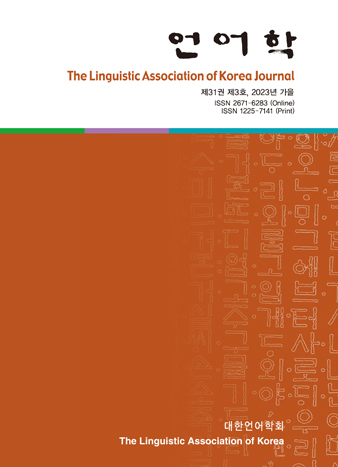대한언어학회 전자저널

-
온라인 수업에서 상호작용 교수설계가 학습몰입과 학습지속의향에 미치는 영향: N대학 교양영어 수업의 사례를 중심으로
-
The Internal Structure of Reflexives and a NP-internal Movement Analysis
-
Chinese Undergraduate Students’ Motivation to Learn L2 English and L3 Korean Simultaneously
-
What Restricts or Boosts the Use of Internally-Headed Relative Clauses in Korean?
-
English Wh-Question Formation by Korean Elementary and Middle School EFL Students
-
Korean ESL Learners’ Individual Differences in Intercultural Sensitivity and Language Development
31권 3호 (2023년 9월)
- English Wh-Question Formation by Korean Elementary and Middle School EFL Students
-
Yuhyeon Cho, Ji-Hye Kim
Pages : 157-173
Abstract
Keywords
# wh-question # argument structure # grammatical relation # Korean EFL learners
References
- Ambridge, B., Rowland, C. F., Theakston, A. L., & Tomasello, M. (2006). Comparing different accounts of inversion errors in children\\\'s non-subject wh-questions: ‘What experimental data can tell us?’. Journal of Child Language, 33(3), 519-557.
- Bloom, L., Merkin, S., & Wootten, J. (1982). \\\"Wh\\\"-Questions: Linguistic factors that contribute to the sequence of acquisition. Child Development, 54(4), 1084-1092.
- Chomsky, N. (1993). Lectures on government and binding: The Pisa lectures (9th ed.). Walter de Gruyter.
- De Villiers, J. (1991). Why questions?. University of Massachusetts Occasional Papers in Linguistics, 17(1), 8.
- Hasebe, M., & Maki, H. (2014). Acquisition of the wh-interrogative construction by Japanese junior high school EFL learners. In R. T. Miller & K. I. Martine (eds.), Selected proceedings of the 2012 Second Language Research Forum: Building bridges between disciplines(pp. 76-88). Somerville, MA: Cascadilla Proceedings Project.
- Kang, J.-H. (2013). A Study on Elementary School Students\\\' Acquisition of Wh-questions: Focusing on Subject-Auxiliary Inversion. (Unpublished MA dissertation). Korea National University of Education, Chungbuk.
- Lee, S.-Y. (2008). Argument-adjunct asymmetry in the acquisition of inversion in Wh-questions by Korean learners of English. Language Learning, 58(3), 625-663.
- Lee, S.-M. (2014). A Study of the Acquisition of Yes/No Questions by Korean ElementarySchool Students Depending on the Verb Types. (Unpublished MA dissertation). Korea National University of Education, Chungbuk.
- Lee, J. (2008). A Study on the Inversion in English Interrogative Acquisition by Korean Middle School Students. (Unpublished MA dissertation). Korea University, Seoul.
- Lightbown, P. M., & Spada, N. (2021). How languages are learned (5th ed.). Oxford: Oxford University Press.
- Muroya, A. (2019). Why are subject Wh-Questions more difficult than object Wh-Questions? A study of Japanese young learners of English. In H. Wilson & N. King (Eds.), Selected proceedings of the 2017 Second Language Research Forum (pp. 144-161). Somerville, MA: Cascadilla Proceedings Project.
- O\\\'Grady, W. (1997). Syntactic development. University of Chicago Press.
- Radford, A. (1994). The syntax of questions in child English. Journal of Child Language, 21(1). 211-236.
- Rowland, C. F. (2000). The grammatical acquisition of wh-questions in early English multi-word speech (Unpublished doctoral dissertation). University of Nottingham, UK.
- Rowland, C. F., & Pine, J. M. (2000). Subject-auxiliary inversion errors and wh-question acquisition: \\\'What children do know?\\\'. Journal of Child Language, 27(1), 157-181.
- Rowland, C. F., & Pine, J. M. (2003). The development of inversion in wh- questions: a reply to Van Valin. Journal of Child Language, 30(1), 197-212.
- Rowland, C. F., Pine, J. M., Lieven, E. V. M., & Theakston, A. L. (2005). The incidence of error in young children’s wh-questions. Journal of Speech, Language, and Hearing Research, 48, 384-404.
- Schwartz, B. D., & Sprouse, R. A. (1996). L2 cognitive states and the Full Transfer/Full Access model. Second Language Research, 12(1), 40-72.
- Spada, N., & Lightbown, P. M. (1999). Instruction, first language influence, and developmental readiness in second language acquisition. The Modern Language Journal, 83(1), 1-22.
- Stromswold, K. J. (1990). Learnability and the acquisition of auxiliaries (Unpublished doctoral dissertation). Massachusetts Institute of Technology, MA.
- Stromswold, K. (1995). The acquisition of subject and object wh-questions. Language Acquisition, 4(1-2), 5-48.
- Vainikka, A., & Young-Scholten, M. (2006). The roots of syntax and how they grow. In B. D. Schwartz & S. Unsworth (Eds.). Paths of Development in L1 and L2 Acquisition: Bonnie D. Schwartz. (pp. 77-106). Philadelphia, PA: John Benjamins.
- Valian, V., Lasser, I., & Mandelbaum, D. (1992). Children’s early questions. Paper presented at the 17th Annual Boston University Conference on Language Development. Boston, MA.
- Van Valin, R. D. (2002). The development of subject-auxiliary inversion in English wh-questions: an alternative analysis. Journal of Child Language, 29(1), 161-175.